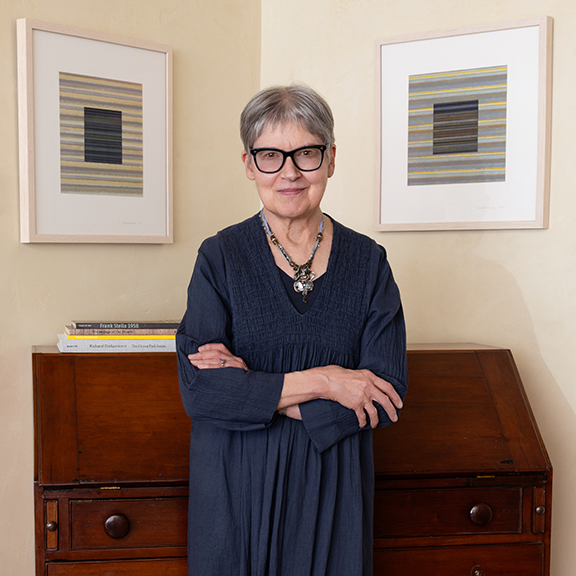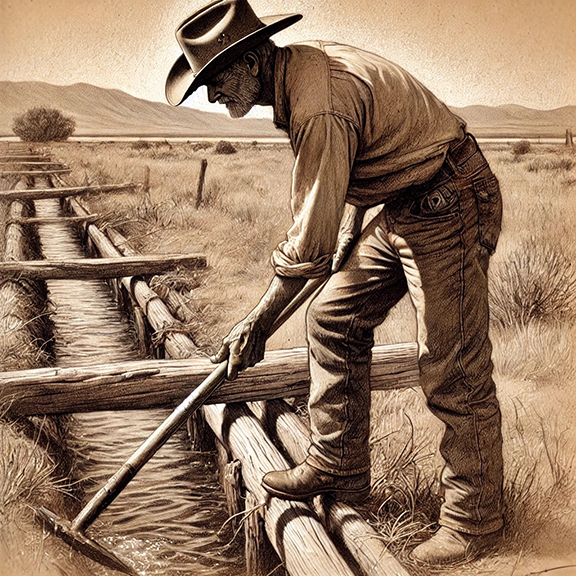The Quiet Pioneer
by Melissa Hampton
This article originally appeared in the Summer 2025 issue of Art with Altitude.
Steamboat Springs has long been a landing place for dreamers and visionaries: homesteaders, outdoor enthusiasts, athletes and artists. To live in Steamboat today is to be the lucky beneficiary of the talents and passions of those trailblazers who came before us, gifting our town with a priceless legacy.
One such family of mid-20th-century pioneers was the Finnoffs. Carol and Bill Finnoff moved to Steamboat Springs in 1969 from Denver. Bill was looking for more outdoor adventure and Carol for new artistic frontiers. Carol brought to the rough-and-tumble Wild West town the quiet conviction that art matters.
In Denver, before present-day buildings housed the Denver Art Museum, Carol had been an early advocate for the establishment of a major art museum. In those days, the early collections were housed in the Chappell House, a 19th-century brownstone neoclassical mansion donated to the Denver Art Association by the heirs of Delos Chappell, an early entrepreneur in the coal industry.
“While Mom was in meetings about the museum, my brother Chris and I explored the secret passageways and hidden doors of that old house,” recalls son Jeff Finnoff. “It was a great adventure!”
Once in Steamboat, Bill Finnoff founded MountainCrafts, catering to outdoor sports enthusiasts.
“My brother, Pete, and I worked in the shop when we were in high school,” remembers son William Finnoff, nicknamed ‘Vee.’ “We sold gear for cross-country skiing, backpacking, camping and kayaking.”
While Bill and the boys immersed themselves in the great outdoors, Carol focused on the budding arts community, finding a kindred spirit in Steamboat’s arts maven, Eleanor Bliss. The two became fast friends, often traveling together and plotting what would be an artistic revolution that would permanently reshape the ranching town.
In May of 1972, the Steamboat Springs Arts Council incorporated with the dual purpose of supporting the arts and restoring the Depot. Carol Finnoff was its first president.
The concept of arts councils was new around the country. In 1965, Lyndon Johnson established the National Arts and Humanities Act, and soon states and local communities began organizing their own arts councils. The Steamboat Springs Arts Council, predecessor to the current creative district, was one of the earliest, due in no small part to the force of the personalities who wanted it to happen.
“These were such strong women,” recalls Noel Hefty. “Eleanor and Carol were the grand dames of the arts community’s early days. I remember sitting in arts council meetings with Carol, who was always knitting or needlepointing. She was very quiet, but when she spoke, it was powerful.”
“She was a presence,” remembers Karolynn Lestrud. “She didn’t say anything unless she had something important to say, but when she did speak, everyone listened. She’d start a sentence with, ‘You know…’ and then offer a concise and improved summation of what everyone else had been waffling about.” Her efforts, along with those of Eleanor Bliss, put Steamboat Springs on the map as a nurturing place for artists to live and pursue their artistic endeavors.
Carol was a lifelong creative and curious about everything. She loved classical music (Mozart was her favorite composer), played the recorder, painted and was an expert at knitting and needlepoint. And when she took up spinning, it was with an unusual twist.
Recalls son Chris Finnoff: “My parents raised Newfoundlands, a breed known for its prodigious shedding. Mom saved the fur gathered from grooming sessions and spun it into yarn…and then made scarves!”
She also loved to travel.
“Mom and various friends traveled extensively,” says son Vee. “Russia, Siberia, Afghanistan, all over Europe, China. In fact, the spinning wheel she used on the Newfie fur was purchased on a trip to Morocco.”
Vee remembers his mom getting him and his brother, Pete, up before school for a daily tutorial on art history.
“We were around ten or eleven years old,” remembers Vee, “wondering why the other kids didn’t have to do this. But even though I didn’t get it at the time, it stuck. To this day, when I’m in a museum somewhere in the world, I’ll remember some tidbit that Mom taught us.”
Carol Finnoff understood that the arts are not just an adornment to a community but a foundation, a force as essential as the rivers and mountains that define this place. While she may not have sought the spotlight, her legacy reminds us that the smallest acts can shape a lifetime and a community.
Elevate the Arts:
How can you contribute to the arts legacy of the Yampa Valley? Teach a class or drop into a class. Buy artwork, attend a performance or even make a donation to the arts nonprofit of your choice. MH




